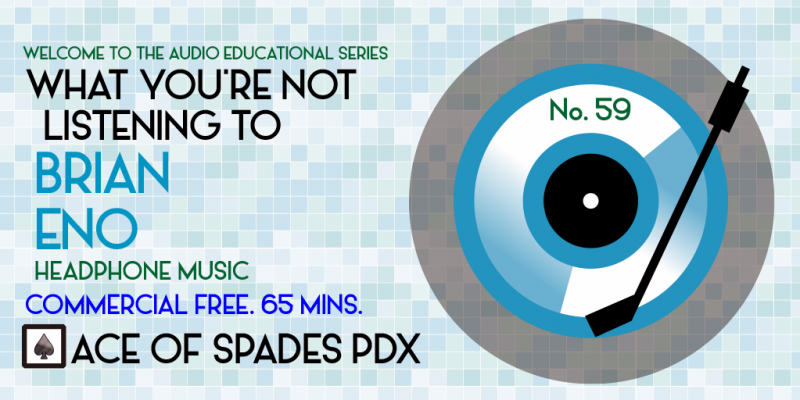Podcast: Play in new window | Download | Embed
A triumph from tragedy story that changed music forever. #eno #brianeno #newage #ambient
It’s a slightly bizarre story, but one befitting the featured artist here. A former art school student, Brian Eno, who studied traditional painting and other mediums, such as sound installations, by chance met a saxophone player named Andy Mackay at a subway station. In 1971, Mackay joined an art rock project, and brought Eno along. The resulting band, Roxy Music, would become of the most influential English groups of the 1970’s, second only to The Sex Pistols in terms of influence and importance.
Eno left after their second album, For Your Pleasure, and embarked on a solo career. Though his first two LP’s were similar to the sound of his previous band, there was definitely a change in the wind. Sadly, Eno was sidelined for a great length of time in 1975 due to a terrible auto accident.

As the legend goes, while Eno was recuperating from home, his then-girlfriend brought him an album of harp music to help him relax. It was also raining at the time. Before she left, she put the album on, not realizing only one speaker was working and the volume was turned down quite low. Too weak to get up and fix the problem, Eno took in the sound of the music and the rain and realized that there was a magic in the relationship of both simultaneously, and it caused him to look at creating music completely differently.
“Well, I am a dilettante.”
Brian Eno
By his 1977 LP, Before and After Science, Eno would not record another Rock and Roll album again, though he became an in-demand session musician and producer, working with just about every major name on the scene for decades, including U2, David Bowie, the Talking Heads and even recently, Grace Jones.
Even though Eno was not the first artist to explore the pre-recorded synthesis between music and nature in a serious, academic way (that honor would probably go to Wendy Carlos with her album Sonic Seasonings), he dove headfirst into the new Ambient and New Age genres, creating classic after classic.

The following 60 minutes primarily focus on his first decade of this solo work, because attempting to create any semblance of an overall historical perspective in the same time frame would be ludicrous due to the sheer volume. Most of it is instrumental, and most of it is in the ambient genre. Overall, it is the sound of someone deciding to take chances with their career, and even though he may not be selling out arenas and stadiums, Eno has carved out a niche as an artist without compromise and full of riches.
Brian Eno Hourlong Headphone Experience
- A Clearing (center channel remix), 1982, Ambient 4: On Land
- Energy Fools The Magician, 1977, Before and After Science
- A Long Way Down, 2005, Another Day On Earth
- The Dance #3, 1980, Ambient 3: Day of Radiance (with Laraaji)
- 2_2, 1978, Ambient 1: Music For Airports
- M386, 1978, Music For Films
- Fullness Of Wind, 1975, Discreet Music
- Broken Head, 1978, After The Heat (with Cluster)
- Mountain Of Needles, 1981, My Life In The Bush of Ghosts (with David Byrne)
- Zawinal/Lava, 1975, Another Green World
- An Ending (Ascent), 1983, Apollo: Atmospheres and Soundtracks
- A Measured Room, 1978, Music For Films
- Thursday Afternoon (edit, final 11 minutes, reverb mix), 1985, Thursday Afternoon
Love to you all.
Ben “Daddy Ben Bear” Brown Jr.
Host, Producer, Webmaster, Audio Engineer, Researcher and Writer
“Copyright Disclaimer Under Section 107 of the Copyright Act 1976, allowance is made for ‘fair use’ for purposes such as criticism, comment, news reporting, teaching, scholarship, and research. Fair use is a use permitted by copyright statute that might otherwise be infringing. Non-profit, educational or personal use tips the balance in favor of fair use.”
